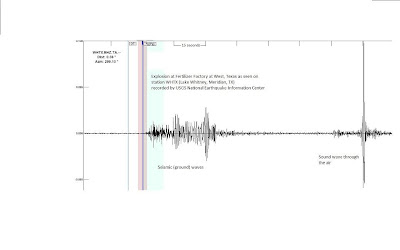Another quick post of some interesting data concerning the explosion at the fertilizer plant in Texas. Yesterday (4/17/13) there was a large explosion at approximately 7:50 pm local time. As of early this morning reports showed around 179 people hospitalized, 24 in critical condition, and 5-15 fatalities. Currently 3-5 firefighters and one law enforcement officer are unaccounted for. Over 60 homes were damaged by the very large blast.
The best video I've seen so far is attached below, the explosion happens around 30 seconds in. Also below is the initial emergency services traffic.
Finally, we can look at data from the Amarillo seismic station (US.AMTX). I've pulled down the data and filtered it to show all frequencies above 1Hz. We expect the explosion to produce mostly high frequency signals and attenuate, or lose strength, quickly (why I didn't see the explosion on any other stations such as US.WMOK in Oklahoma). It looks like there are 6 main pulses of energy (possibly tanks failing?) very quickly and the large explosion in a period of around 10 seconds. 
If you want to look at the data yourself I've made the SAC file available here or you can download the data from IRIS and duplicate the filtering with the following OBSPy code:
EDIT: The USGS posted a transportable array station that was closer to the event (seismogram below) that shows both the fast ground waves and the slower air blast. They classify this as a magnitude 2.1 event on the event page, but it's really a larger explosion than that hints at as magnitude is only based upon ground motion.




